Nanette Londeree
Master Rosarian, Marin County Rose Society
This article is a 2019 Award of Merit winner
The world is filled with insects – it’s estimated that there are more than a million different species. Most go about their daily business nearly invisible to us – pollinating plants, breaking down dead material and being served up as meals for birds, fish and other creatures. Some provide us with the invaluable service of keeping pest populations in check – the good bugs battling the bad ones.
Good bugs, also known as beneficial insects and natural enemies, are predators and parasites that control pests by eating them. Predators attack kill and feed on their prey like the spider that ensnares the fly. Parasites are like the vampires of the insect world, seeking out victims for their blood or body fluids and living on (or in) their host.
Encouraging beneficials in your garden is about the greenest method of pest control you can use. “Bug-on-bug” warfare is the way things exist in nature, and while it may not provide you with a pest-free environment, you can reach a tolerable level of damage without the use of any type of chemical control. It’s easy to do. If you know what they look like, their preferred environment and favored foods, you’ll be on your way to creating a more balanced and sustainable gardening environment – that’s good for you and your roses!
You already know the virtues of lady bugs and garden spiders, meet some other beneficials:
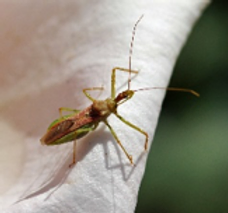
Assassin bugs are rapacious predators of aphids, caterpillars, leafhoppers and other bugs (including some other beneficials). The black, brown or brightly colored slender adult insects are about 1/2 to 3/4-inch long with an extended needle-like beak and enlarged bristly front legs. Though winged, they’re poor fliers, and are most likely seen lying in wait for their prey.

The ethereal-looking green lacewings, with their slender pale green body, delicate gossamer wings and immense golden eyes, are natural enemies of several species of aphids, spider mites, leafhoppers, mealybugs, leaf miners, thrips, whiteflies, small caterpillars, beetle larvae and insect eggs. The easily identifiable adults are not the main predators – it’s the ferocious, grayish to brown, mottled and spiny alligator-shaped larvae that are the ravenous hunters.
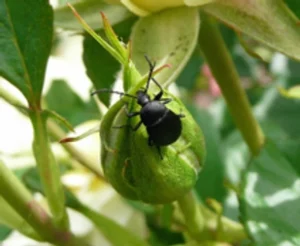
Ground beetles are often abundant in gardens, but due to their generally nocturnal habits, aren’t seen much. These voracious predators may consume their weight in pests every day. They stalk soil-dwelling insects, caterpillars, beetle grubs, grasshoppers, and other small animals such as snails and slugs. The larvae are equally aggressive; they live below ground where they use their large pincher-like mandibles to devour soil-dwelling insects.
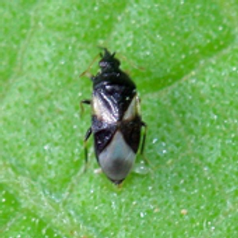
About the same to twice the size of an aphid, minute pirate bugs are black to purplish in color with a characteristic X-shape or chevron on their back. Often the first and most common predaceous insects to appear in the spring, the fierce, generalist predators feast on aphids, leafhoppers, spider mites, thrips, whiteflies, small caterpillars and other tiny insects and their eggs. They feed by sucking juices from their prey through a sharp needle-like beak; one of these hungry critters can consume 30 or more spider mites per day! While great to have in the garden, be careful; like assassin bugs, they can inflect an irritating bite to humans if threatened.

Soldier beetles are predators to a host of bad bugs including aphids, cucumber beetles, spider mites, various caterpillars, grasshopper eggs, beetle larvae and other insects and their eggs. Also known as leather-winged beetles, adults are relatively soft bodied, straight-sided beetles about one-half inch long with a red, orange or yellow head and abdomen.
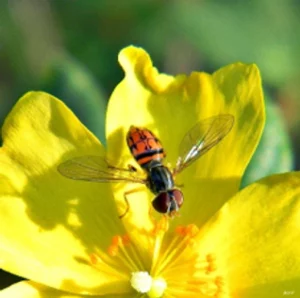
Syrphid flies appear like a small bee hovering helicopter-style over a flower. Commonly known as flower flies or hover flies, the brightly colored adults range in size from 1/4 to 3/4-inch long, are black or brown with yellow banded abdomens and body markings. Though their resemblance to bees may be striking, syrphid flies have a single pair of wings, compound eyes and stubby antennae, while bees are equipped with two pairs of wings, simple eyes and long antennae. Again, it’s the larvae that are the predators going after aphids, small caterpillars, thrips and other small insects, consuming as many as 400 aphids in their very short lifetime. The adults feast on pollen and nectar; and their movement from flower to flower makes them an important pollinator.
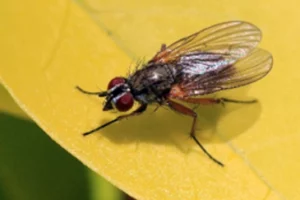
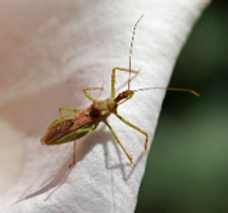
Types of parasitic wasps and tachinid flies are the most common parasitoid insects. The nearly invisible, non-stinging wasps with their trademark narrow wasp-waist, attack caterpillars, flies, true bugs and beetles. The immature forms do the damage, getting their nutrition by feeding in or on the body of another insect, while the mature forms are free-living and most often feed on pollen and nectar. Tachinid flies resemble houseflies and are covered with stiff hairs. They are endoparasitoids, developing inside their victims that include the larvae of moths, beetles, sawflies, stink bugs and other insects.
To attract the good guys to inhabit your garden, provide them with food, water and shelter. Diverse plant types encourage a range of beneficials. Some favorites are members of the carrot family – dill, fennel and parsley; the daisy family – coneflowers, daisies and yarrow, and herbs like rosemary and thyme. Use local native flowering plants, trees and shrubs to best meet the needs of local parasitoids. Include plants with different flowering times to provide nectar and pollen all season long. Avoid toxic chemicals and tolerate low populations of insect pests to ensure that food is available for the hungry garden helpers.




























































